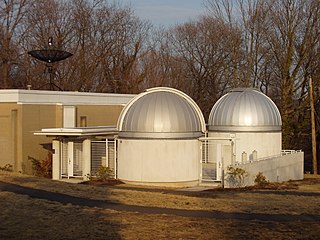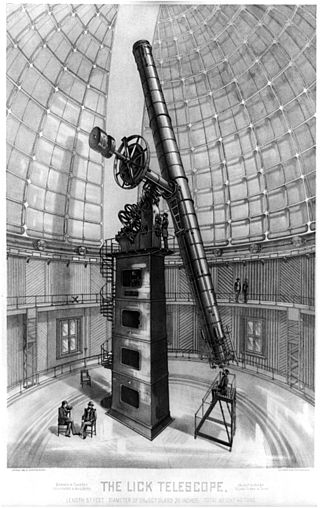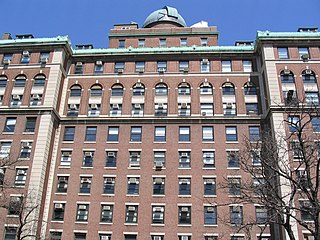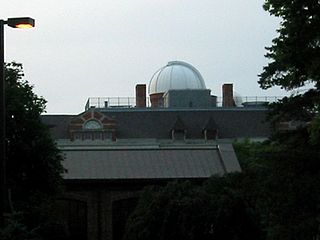
Lowell Observatory is an astronomical observatory in Flagstaff, Arizona, United States. Lowell Observatory was established in 1894, placing it among the oldest observatories in the United States, and was designated a National Historic Landmark in 1965. In 2011, the Observatory was named one of "The World's 100 Most Important Places" by Time Magazine. It was at the Lowell Observatory that the dwarf planet Pluto was discovered in 1930 by Clyde Tombaugh.

Yerkes Observatory is an astronomical observatory located in Williams Bay, Wisconsin, United States. The observatory was operated by the University of Chicago Department of Astronomy and Astrophysics from its founding in 1897 to 2018. Ownership was transferred to the non-profit Yerkes Future Foundation (YFF) in May 2020, which began restoration and renovation of the historic building and grounds. Re-opening for public tours and programming began May 27, 2022.

The Harvard College Observatory (HCO) is an institution managing a complex of buildings and multiple instruments used for astronomical research by the Harvard University Department of Astronomy. It is located in Cambridge, Massachusetts, United States, and was founded in 1839. With the Smithsonian Astrophysical Observatory, it forms part of the Center for Astrophysics | Harvard & Smithsonian.
Boyden Observatory is an astronomical research observatory and science education centre located in Maselspoort, 20 kilometres (12 mi) north-east of the city of Bloemfontein in Free State, South Africa. The observatory is managed by the Physics Department of the University of the Free State (UFS). The Friends of Boyden assist the observatory as a public support group, organising open evenings and protecting its public interest. Boyden also makes use of members of ASSA Bloemfontein Centre, the amateur astronomy club of the city, for presenters and telescope assistants.

The Pulkovo Astronomical Observatory, officially named the Central Astronomical Observatory of the Russian Academy of Sciences at Pulkovo, is the principal astronomical observatory of the Russian Academy of Sciences. It is located 19 km south of Saint Petersburg on Pulkovo Heights 75 metres (246 ft) above sea level. It is part of the UNESCO World Heritage Site Historic Centre of Saint Petersburg and Related Groups of Monuments. It was formerly known as the Imperial Observatory at Pulkowo.

Space Place at Carter Observatory is an observatory in Wellington, New Zealand, located at the top of the Wellington Botanic Garden.

The Maria Mitchell Observatory in Nantucket, Massachusetts, USA, was founded in 1908 and named in honor of Maria Mitchell, the first American woman astronomer. It is a major component of the Maria Mitchell Association. The Observatory actually consists of two observatories - the main Maria Mitchell Observatory near downtown Nantucket and the Loines Observatory about a kilometer west of town. It is also the repository for a valuable collection of over 8000 wide-field glass photographic plates, recording observations of large swaths of sky from 1913 to 1995.
Laws Observatory is the name of three separate astronomical observatories owned and operated by University of Missouri from 1880 to the present. Named after former University President Samuel Laws, it is located in Columbia, Missouri (USA).

Chamberlin Observatory is an astronomical observatory owned and operated by the University of Denver. It is located in Denver, Colorado (US) in Observatory Park. It is named for Humphrey B. Chamberlin, a Denver real estate magnate who pledged $50,000 in 1888 to build and equip the facility.

The Warner and Swasey Observatory is the astronomical observatory of Case Western Reserve University. Named after Worcester R. Warner and Ambrose Swasey, who built it at the beginning of the 20th century, it was initially located on Taylor Road in East Cleveland, Ohio, USA. The observatory, which at that time housed a 9.5-inch (24 cm) refractor, was donated in 1919 to the Case School of Applied Science. The newer 24-inch (61 cm) Burrell Schmidt telescope was built in 1939.

The Yale University Observatory, also known as the Leitner Family Observatory and Planetarium, is an astronomical observatory owned and operated by Yale University, and maintained for student use. It is located in Farnham Memorial Gardens near the corner of Edwards and Prospect Streets, New Haven, Connecticut.

Alvan Clark & Sons was an American maker of optics that became famous for crafting lenses for some of the largest refracting telescopes of the 19th and early 20th centuries. Founded in 1846 in Cambridgeport, Massachusetts, by Alvan Clark, and his sons George Bassett Clark (1827–1891) and Alvan Graham Clark (1832–1897). Five times, the firm built the largest refracting telescopes in the world. The Clark firm gained "worldwide fame and distribution", wrote one author on astronomy in 1899.

Rutherfurd Observatory is the astronomical facility maintained by Columbia University named after Lewis Morris Rutherfurd. Initially, Rutherfurd housed its telescopes and equipment in midtown Manhattan and later on the Stuyvesant Estate. When the Morningside campus was built, telescopes were kept in a "transit building" where the Interdisciplinary Science Building now stands. When Pupin Physics Laboratories were completed in 1927, the home of the observatory was moved to the top of the building. Below the Rutherfurd Observatory on the 14th floor was the site of Professor Wallace Eckert's Astronomical Laboratory, in which he constructed the first device to perform general scientific calculations automatically in 1933-34.

Michigan State University Observatory is an astronomical observatory owned and operated by Michigan State University. It is located south of the Michigan State University campus in East Lansing, Michigan (USA), near the corner of Forest Rd and College Rd. It has a Cassegrain telescope in its single dome. Built by Boller and Chivens, the Michigan State University telescope was commissioned in 1969 and entered regular operation in 1970. In 1974, what was at the time a state-of-the-art Raytheon Microcomputer was installed to function as a data gathering and control system. Originally, single channel photoelectric photometry and photography using plates or film were the means of acquiring data. The observatory was closed from 1981 until 1986, at a time when the university was having financial difficulties. It was reopened in the spring of 1986 on the occasion of the return of Comet Halley and has been in regular operation ever since. Since the 1980s, a CCD camera has been employed as the main instrument and the Raytheon computer has been retired. The International Astronomical Union has assigned the MSU Observatory identification code 766.

The Dearborn Observatory is an astronomical observatory located on the Evanston campus of Northwestern University. The observatory was originally constructed in 1888, through an agreement between the university and the Chicago Astronomical Society. In the summer of 1939, Dearborn Observatory had to be moved to make way for the construction of the Technological Institute.

Pritchett College was a small institution that operated in Glasgow, Missouri from 1866 until 1922. It was founded as Pritchett School Institute and became known as Pritchett College after 1897.
Bernice Morrison (1856–1947) was an American heiress and benefactor of the Morrison Observatory.
Carr Waller Pritchett Sr. (1823–1910) was an American educator and astronomer. He served briefly as president of Central College just before the American Civil War. He then became the first president of Pritchett School Institute in Glasgow, Missouri, after the war, and he was the first director of the Morrison Observatory, also in Glasgow..

Sherzer Observatory is an astronomical observatory located on the campus of Eastern Michigan University. The observatory was established in 1903 with the construction of the new Natural Science Building, in Ypsilanti, Michigan. Following a devastating fire in 1989 a new observatory opened in September 1991 with a 10-inch (250 mm) apochromatic refractor telescope and German equatorial mount centered under a 6-meter dome.

Arago telescope is a 38 cm aperture refracting telescope at Paris Observatory, installed in 1857. Francois Arago ordered this telescope from the telescope making firm Lebreours in 1839, and after a protracted development was completed by 1855. The name Lunette Arago is a modern name for the telescope, and other large refractor of Paris observatory, is the one at Meudon. It has gone by a variety of names having to do with various aspects of the telescope, such as its aperture, or location on the East tower of the Paris observatory, or its equatorial mount made by Brunner. In one journal report it was called the 'east equatorial' for example, in another instance '38 cm refractor'. In French language it has been called the La lunette équatoriale de 38 cm de l'Observatoire de Paris.

















